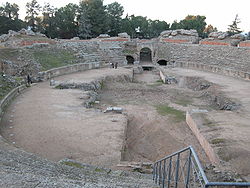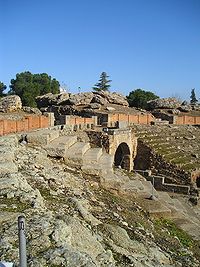- Mérida amphitheatre
-
Archaeological Ensemble of Mérida * UNESCO World Heritage SiteCountry Spain Type Cultural Criteria iii, iv Reference 664 Region ** Europe and North America Inscription history Inscription 1993 (17th Session) * Name as inscribed on World Heritage List
** Region as classified by UNESCOThe Amphitheatre of Merida, was built in the roman colony of Emerita Augusta, which was founded in 25 B.C. by Octavius Augustus, emeritus soldiers discharged from the Roman army, two veteran legions of the Cantabrian Wars: Legio V Alaudae and Legio X Gemina. The city was the capital of the Roman province of Lusitania. The term emeritus meant in latin "retired" and referred to retired soldiers with honor.
The amphitheater is part of The Archaeological Ensemble of Mérida, which is one of the largest and most extensive archaeological sites in Spain. It was declared a World Heritage Site by UNESCO in 1993.
Contents
History
Construction was popular with more depth than the theater itself, and was inaugurated in the year 8 B.C. This building was intended for gladiatorial combats. between beasts or men and beasts, so-called venationes.
Architectural features
Had an elliptical shape, and had a major axis of 126 m. and one less than 102 m, with these measures in the arena of 64 m. by 41 m. respectively.
The sand had a 'fossa bestiaria' in the center, which was covered with wood and sand. This fossa is used to house animals that later would face the gladiators.
Its design consists of: a grandstand with ima, media and summa cavea, and a central arena. The stands had a carrying capacity of approximately 15,000 spectators and available -Scalae- stairs and hallways that connected the different parts -cune.
The ima cavea had of a row reserved for the ruling class and 10 more for the public commoner. Also built two stands located at both sides of the minor axis, one above the main entrance hall and another in front. Under them were the inscriptions with which they could date the amphitheater.
The amphitheater is located in these conditions because this is where they faced the Romans against the Carthaginians in the Punic wars.
See Also
- Archaeological Ensemble of Mérida
External links
- Official website of the City council of Merida
- Official website of the entity that manages the amphitheater and the archaeological ensemble
Coordinates: 38°54′58.3″N 6°20′15.8″W / 38.916194°N 6.337722°W
Categories:- 1st-century BC architecture
- Buildings and structures in Mérida, Spain
- Roman amphitheatres
- Ancient Roman buildings and structures in Spain
Wikimedia Foundation. 2010.


